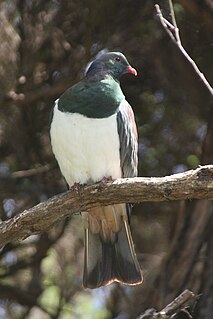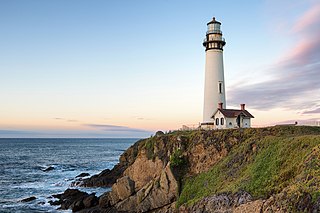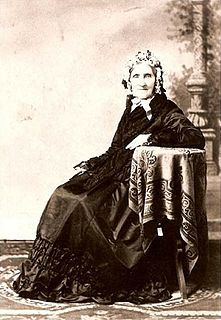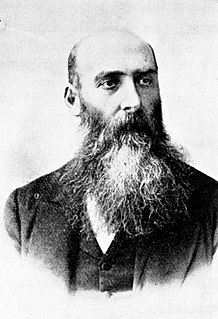
The Bay of Islands is an area on the east coast of the Far North District of the North Island of New Zealand. It is one of the most popular fishing, sailing and tourist destinations in the country, and has been renowned internationally for its big-game fishing since American author Zane Grey publicised it in the 1930s. It is 60 km (37 mi) north-west of the city of Whangarei. Cape Reinga, at the northern tip of the country, is about 210 km (130 mi) by road further to the north-west.

The New Zealand pigeon or kereru is a bird endemic to New Zealand. Māori call it kererū in most of the country but kūkupa and kūkū in some parts of the North Island, particularly in Northland. Commonly called wood pigeon, they are distinct from the wood pigeon of the Northern Hemisphere, which is a member of a different genus.

Wairoa is a town and territorial authority district in New Zealand's North Island. The town is the northernmost in the Hawke's Bay region, and is located on the northern shore of Hawke Bay at the mouth of the Wairoa River and to the west of Mahia Peninsula. It is 118 kilometres northeast of Napier, and 92 kilometres southwest of Gisborne. Percentage-wise, it is often known for being New Zealand's most Maori town, with over 62.29% of the population identifying themselves as Maori. At the same time, it is also the largest town within the district of Wairoa.

Whangaparaoa Peninsula is a suburban area about 25 km north of Auckland in New Zealand. It had 30,672 residents in 2013, many of them in the eponymous town of Whangaparaoa on its southern side. It is part of the Hibiscus Coast.

Cape Hallett is a snow-free area on the northern tip of the Hallett Peninsula on the Ross Sea coast of Victoria Land, East Antarctica. Cape Adare lies 100 km (62 mi) to the north.

King Edward VII Land or King Edward VII Peninsula is a large, ice-covered peninsula which forms the northwestern extremity of Marie Byrd Land in Antarctica. The peninsula projects into the Ross Sea between Sulzberger Bay and the northeast corner of the Ross Ice Shelf, and forms part of the Ross Dependency. Edward VII Peninsula is defined by the Ross Ice Shelf on the southwest, Okuma Bay on the west, and to the east by Sulzberger Bay and the Saunders Coast, all essentially on the Ross Sea / Southern Ocean in Antarctica. The northwest extremity of the peninsula is Cape Colbeck. Edward VII Peninsula is located at 77°40′S 155°00′W.
Akaroa was a New Zealand electorate. It was located in on Banks Peninsula, in Canterbury, and named after the town of the same name. One of the original 24 electorates, it existed from 1853 to 1893.
The following lists events that happened during 1837 in New Zealand.
The following lists events that happened during 1834 in New Zealand.
Broad Bay may refer to the following locations:

The settlement of Broad Bay is located on the Otago Harbour coast of Otago Peninsula, in the South Island of New Zealand. It is administered as part of the city of Dunedin, and is technically a suburb of that city, though its isolation and semi-rural nature make it appear as a settlement in its own right.
Ellesmere was a parliamentary electorate in the Canterbury region of New Zealand. It existed for two periods between 1861 and 1928 and was represented by six Members of Parliament.

Pigeon Point is an isolated peninsula located at the northeast extremity of Minnesota, in Cook County, Minnesota, United States. To the north of the point lies Pigeon Bay, which shares a shoreline with Canada and to the south is Lake Superior. Pigeon Point is the closest mainland U.S. point to Isle Royale, on the far side of the water boundary between Minnesota and Michigan. The extreme end of the point is owned by the United States Coast Guard while the land up to the point is held by the Grand Portage Indian Reservation. The closest town to the point is Grand Portage, Minnesota which lies thirteen miles to the west. There are no roads that lead to this point and is only accessible by boat.

Arneb Glacier or Hallett Glacier is a glacier 3 nautical miles (6 km) long and 2 nautical miles (4 km) wide, situated in a cliff-walled bay between Hallett Peninsula and Redcastle Ridge and flowing northwest into Edisto Inlet as a floating ice tongue. It was named by the New Zealand Geological Survey Antarctic Expedition, 1957–58, for USS Arneb, which in the 1957 season carried the buildings and stores for the establishment of Hallett Station and revisited the station in subsequent seasons.

Pigeon Point Light Station or Pigeon Point Lighthouse is a lighthouse built in 1871 to guide ships on the Pacific coast of California. It is the tallest lighthouse on the West Coast of the United States. It is still an active Coast Guard aid to navigation. Pigeon Point Light Station is located on the coastal highway, 5 miles (8 km) south of Pescadero, California, between Santa Cruz and San Francisco. The 115-foot (35 m), white masonry tower, resembles the typical New England structure. Because of its location and ready access from the main highway, Pigeon Point entertains a large number of public visitors.

Elizabeth McHutchison Sinclair was a Scottish homemaker, farmer and plantation owner in New Zealand and Hawaii, best known as the matriarch of the Sinclair family that bought the Hawaiian island of Niʻihau in 1864. Born in Glasgow, Scotland, she married Francis Sinclair, a ship's captain. With six children in tow, the family moved to New Zealand. Her husband and eldest son were later lost at sea.

William Sanderson Fitzgerald was a New Zealand teacher and educationalist. He was born in Musselburgh, Midlothian, Scotland on 12 November 1838. In 1861, he was appointed by the Free Church of Scotland to be principal of a Presbyterian boarding and day school in Pigeon Bay on Banks Peninsula in New Zealand's South Island. He and his wife reached Lyttelton in October 1861. At Pigeon Bay, they had twins on 20 March 1862, including the cricketer James Fitzgerald.
David Taylor "Dick" Stewart was a New Zealand rugby union player. A loose forward, Stewart represented South Canterbury at a provincial level, making 15 appearances for the team between 1890 and 1896. He played just one match for the New Zealand national side, against New South Wales at Lancaster Park in Christchurch.
James Fitzgerald was a New Zealand cricketer and physician.














